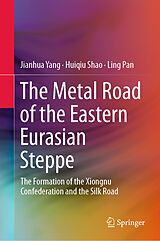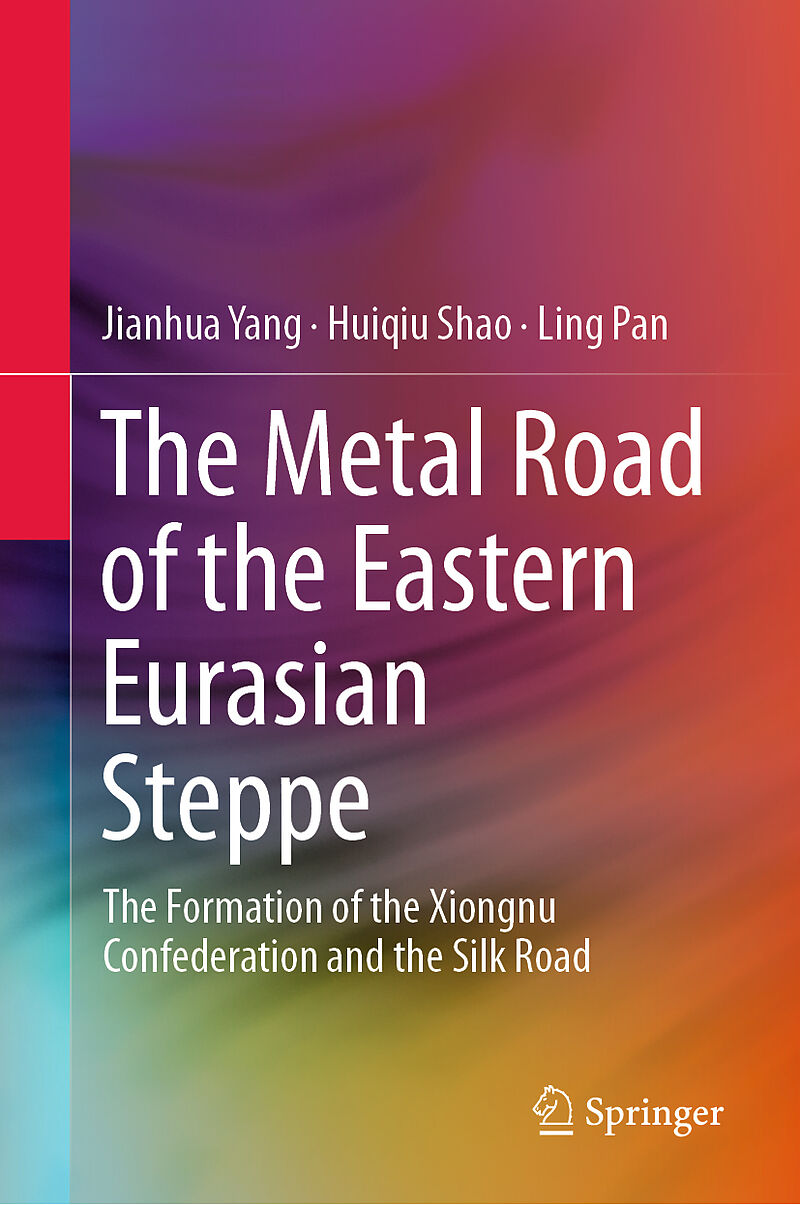The Metal Road of the Eastern Eurasian Steppe
Einband:
Fester Einband
EAN:
9789813291546
Untertitel:
The Formation of the Xiongnu Confederation and the Silk Road
Genre:
Sozialwissenschaften, Recht & Wirtschaft
Autor:
Jianhua Yang, Ling Pan, Huiqiu Shao
Herausgeber:
Springer Nature Singapore
Auflage:
1st ed. 2020
Anzahl Seiten:
640
Erscheinungsdatum:
30.01.2020
ISBN:
9813291540
This book is one of the first to systematically explore cultural interactions between the Northern Zone of China and the Eurasian Steppe, with a focus on the formation process of the Xiongnu Confederation and the Silk Road. Combining partition and staging analyses, the authors adopt a broad perspective, viewing the Northern Zone as part of the Eurasian Steppe and combining history with culture by investigating the spread of bronze artifacts. In addition, with more than three hundred figures and color photographs, it offers readers a uniquely grand panorama of two thousand years of cultural interactions between the Northern Zone of China and the Eurasian Steppe.
Offers the first systematic exploration of cultural interactions between the Northern Zone of China and the Eurasian Steppe, shedding new light on the formation process of the Xiongnu Confederation and the Silk Road Provides critical evidence that the Rong, Di and Hu ethnic groups have played a major historical role in shaping the relationship between the Central Plains culture and the nomadic culture of North Asia Offers a grand panorama of two thousand years of cultural interactions between the Northern Zone of China and the Eurasian Steppe, with more than three hundred figures and color photographs
Autorentext
Dr Jianhua Yang is a Professor of Archaeology at Jilin University, Visiting Research Fellow at the Center for Ancient Civilization Studies of the Chinese Academy of Social Sciences (CASS), member of the Academic Committee of the CASS Institute of Archaeology, and standing member of the Chinese Archaeology Society. She has been a Senior Visiting Scholar at the University of Cambridge, UK (1993-1994, 2002), and at the University of Pittsburgh, USA (2007-2008). Her research interests include archaeological theory, historical development of archaeology as a discipline, West Asian archaeology, and Bronze Age archaeology in Northern China.
Dr Huiqiu Shao is a Professor of Archaeology at Jilin University, and has been a Visiting Scholar at the University of Pennsylvania, USA (2012-2013). His research interests include Bronze Age archaeology in Northern China, Xinjiang archaeology and Eurasian Steppe archaeology.
Dr Ling Pan is a Professor of Archaeology at Jilin University. Her research interests include Chinese northern frontier archaeology, Warring-States archaeology, Qin Dynasty archaeology and Han Dynasty archaeology.
Inhalt
FORWARD
PREFACE I. The Geography of the Eurasian Steppe II. The History of Research on the Relations between the Northern Zone of China and the Eurasian Steppe III. About the Book CHAPTER ONE THE GERMINATION OF NORTHERN BRONZES 1.1 Different Bronze Systems in Eurasia 1.1.1 Eastern bronze culture system 1.1.2 Western bronze culture system 1.1.3 Bronze culture system during the late prehistoric period 1.2 Research Background beyond China Related to Chinese Early Bronzes 1.2.1 Early bronzes of the Oasis culture in southern Central Asia 1.2.2 Early bronzes of the steppe culture 1.2.3 Seriation of some early bronzes 1.3 The Formation of Different Systems of Early Chinese Bronzes 1.3.1 Central Plain bronze system during the Xia period 1.3.2 Northern bronze system during the Xia period 1.3.3 Early bronzes of the Northwestern bronze system during the Xia period 1.4 Relationship between the Early Bronzes from China and Those outside of China 1.4.1 Relationship between the bronzes of the Qijia culture and those outside of China 1.4.2 Relationship between the bronzes of the Siba culture and those of the Tianshanbeilu culture and those beyond the borders of China 1.4.3 The prototype of the Northern Zone of China-the Mongolian Plateau Metallurgical Province CHAPTER TWO THE EXPANSION OF THE STEPPE CULTURE DURING THE SECOND MILLENNIUM B.C. 2.1 Andronovo Culture and Seima-Turbino Culture 2.1.1 Andronovo culture and socketed battle axes in steppe 2.1.2 Characteristics, dating and population of the Seima-Turbino remains 2.1.3 Relationship between the two types of remains 2.2 Relevant Remains in China 2.2.1 Relevant remains of the Andronovo culture complex found in Xinjiang 2.2.2 Socketed battle axes in Xinjiang and the Northern Zone 2.2.3 Hollow-head axes in Xinjiang and the Northern Zone of China 2.2.4 Bronze spears with Seima-Turbino characteristics found in China 2.3 The Cultural Relations between China and the Steppe Zone during the 2000 B.C. 2.3.1 Expansion of the Andronovo culture complex in Xinjiang 2.3.2 The spread of socketed battle axes 2.3.3 Spread of axes 2.3.4 Seima-Turbino-type bronze spears 2.3.5 Summary CHAPTER THREE THE EMERGENCE AND EXPANSION OF BRONZES IN THE NORTHERN ZONE OF CHINA 3.1 Emergence of the Northern Bronzes 3.1.1 Northern bronzes during the early Shang period 3.1.2 Northern bronzes from the late Shang to West Zhou 3.1.3 Evolution of the major bronzes 3.2 Eurasian Steppe at the End of the 2nd Millennium B.C. 3.2.1 Kazakh steppes, East European steppe, and forest steppes in the post-Seima period 3.2.2 Early bronze artifacts in the Mongolian region 3.2.3 Karasuk culture in the Minusinsk Basin 3.3 The Spread of Chinese Northern Bronzes 3.3.1 The influence of northern bronzes on Central Plain culture 3.3.2 The influence of northern bronzes on the north of the Yan Mountains 3.3.3 The relationship between northern bronze and the Mongolian Plateau 3.3.4 The relationship between the northern bronze and Minusinsk Basin 3.3.5 The influence of the northern bronzes on the steppes beyond the border, taking the bronze short sword as an example CHAPTER FOUR THE BEGINNING OF THE EARLY NOMADIC AGE 4.1 The Beginning of the Nomadic Culture of the Eurasian Steppe 4.1.1 The northern coast of the Black Sea and the Kuban River Basin: The pre- and early Scythian cultures 4.1.2 South Siberia in Russia: the Arzhan Kurgan 4.1.3 Slab Grave culture in the Mongolian Plateau and Trans-Baikal 4.2 The Predecessor of Nomadic Civilization in the Northern Zone of China 4.2.1 Upper Xiajiadian culture 4.2.2 Kayue culture 4.3 Contact between the Northern Zone of China and the Eurasian Steppe 4.3.1 The relationship between the Upper Xiajiadian culture and the Slab Grave culture 4.3.2 Cultural interaction between the Upper Xiajiadian culture and South Siberia and the Black Sea 4.3.3 Division of the middle and eastern Eurasian Steppe and their characteristics 4.4 Conjectures of Transition from Animal Husbandry to Nomadic Pastoralism CHAPTER FIVE THE NORTHERN ZONE OF CHINA AND THE EURASIAN STEPPE IN THE EARLY IRON AGE 5.1 The Prosperous Nomadic Culture in the Eurasian Steppe 5.1.1 The Scythian culture 5.1.2 The Sauro-Sarmatian culture 5.1.3 The Saka culture 5.1.4 The Tagar culture 5.1.5 The early nomadic culture in the Tuva area 5.1.6 The early nomadic culture in the Altai region 5.1.7 The Slab Grave culture 5.2 Formation of the Northern Cultural Belt of China 5.2.1 The sites of the Di in Northern China 5.2.2 Remains related to the Hu in the Northern Zone 5.2.3 Differences between two types of sites in the Northern Zone of China during the Eastern Zhou Period 5.3 Interactions between the Northern Zone of China and the Eurasian Steppe 5.3.1 Interactions with the Mongolian Plateau and Transbaikal 5.3.2 Interactions with Minusinsk and Tuva 5.3.3 Connections with the Altai region 5.3.4 Connections with the Semirechye region in the Tianshan Mountains 5.4 Further Exploration of the Origin of the Xiongnu 5.4.1 Comparison between the earliest Xiongnu remains and the related remains of the Northern Zone of China and the Mongolian Plateau 5.4.2 Discussion CHAPTER SIX CULTURAL CONNECTIONS BETWEEN THE NORTHERN ZONE OF CHINA AND THE EURASIAN STEPPE IN THE XIONGNU TIMES 6.1 Study on the Staging of Xiongnu Remains 6.1.1 Description of related concepts 6.1.2 Staging the Xiongnu remains in Mongolia and the Transbaikal region 6.1.3 The l…

Leider konnten wir für diesen Artikel keine Preise ermitteln ...
billigbuch.ch sucht jetzt für Sie die besten Angebote ...
Die aktuellen Verkaufspreise von 6 Onlineshops werden in Realtime abgefragt.
Sie können das gewünschte Produkt anschliessend direkt beim Anbieter Ihrer Wahl bestellen.
Loading...
Die aktuellen Verkaufspreise von 6 Onlineshops werden in Realtime abgefragt.
Sie können das gewünschte Produkt anschliessend direkt beim Anbieter Ihrer Wahl bestellen.
| # | Onlineshop | Preis CHF | Versand CHF | Total CHF | ||
|---|---|---|---|---|---|---|
| 1 | Seller | 0.00 | 0.00 | 0.00 |
